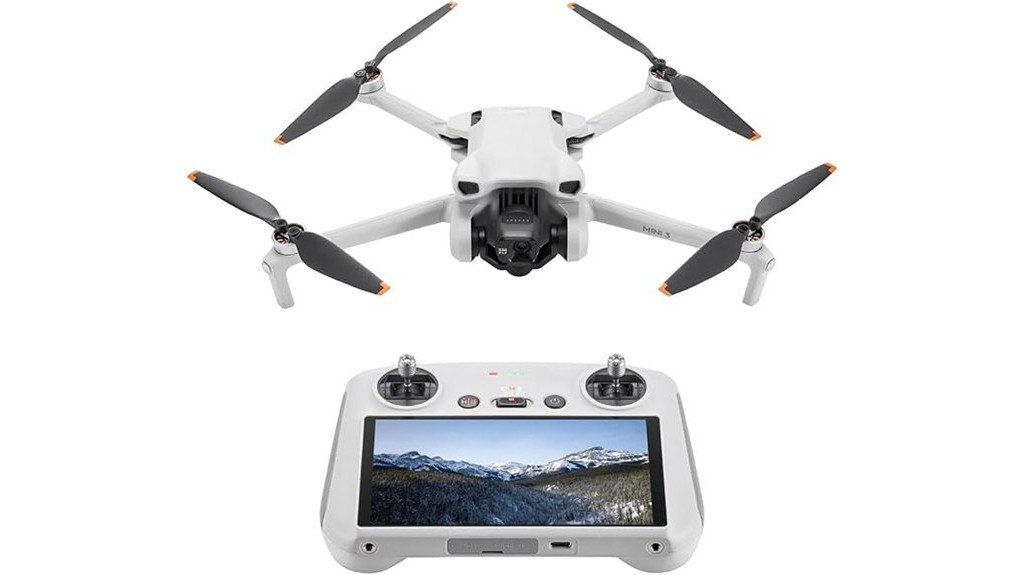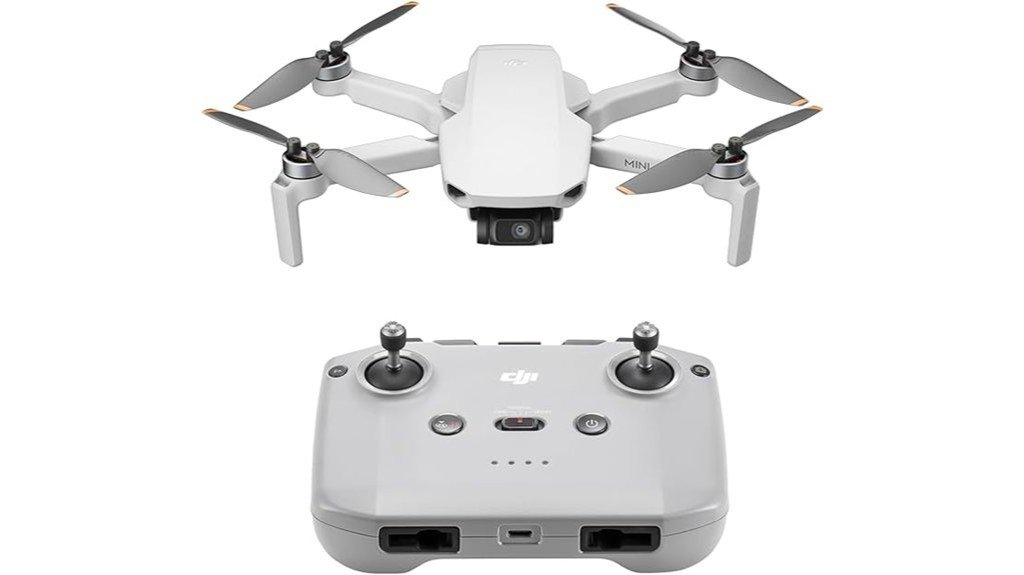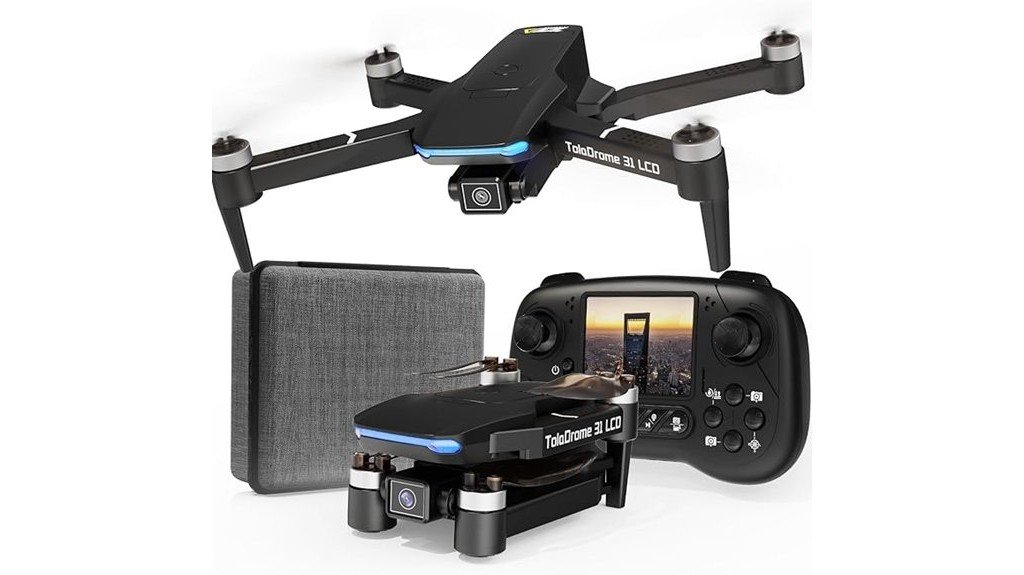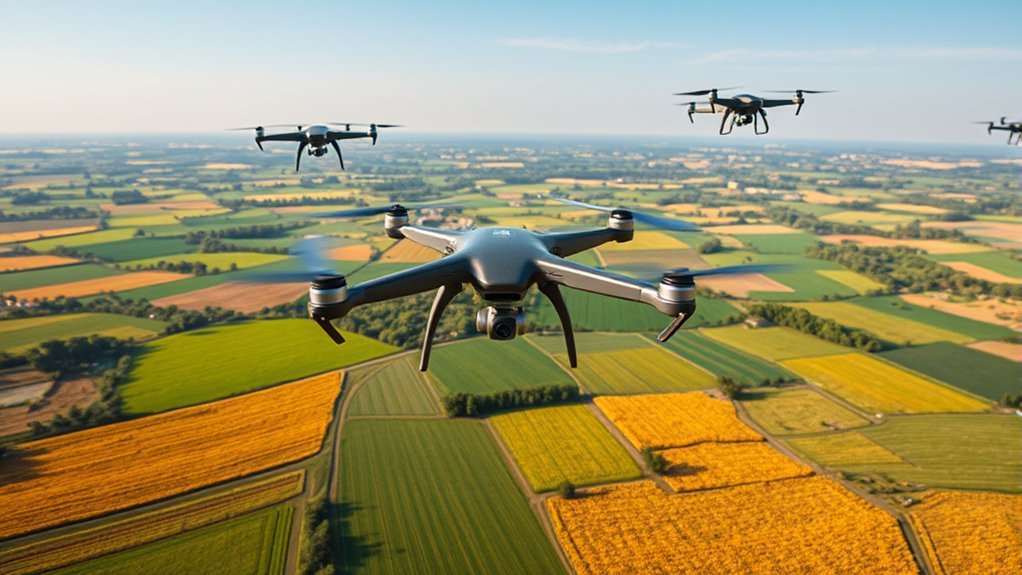If you’re looking to take your farming to the next level, incorporating drones into your routine can be a game changer. With advancements in technology, certain models stand out for their capabilities in agriculture. From enhanced crop monitoring to improved productivity, the right drone can make a significant difference. Curious about which drones can elevate your farming experience? Let’s explore the top three options that might just fit your needs perfectly.
DJI Mini 3 Drone with Camera (DJI RC)

The DJI Mini 3 Drone with Camera (DJI RC) is an excellent choice for farmers looking to enhance their agricultural practices with aerial imagery. Weighing just 248 grams, you won’t need to worry about FAA registration for recreational use. With a remarkable flight time of up to 38 minutes, and stunning 4K UHD video quality, capturing detailed images of your crops is effortless. Its compact design and 3-axis gimbal guarantee stability and portability. Plus, with wind resistance up to 38 kph and smart battery management, you can fly confidently knowing your drone will return safely.
Best For: Farmers looking to enhance their agricultural practices with aerial imagery and detailed crop monitoring.
Pros:
- Excellent 4K UHD video quality for capturing detailed imagery.
- Lightweight design (248 grams) eliminates the need for FAA registration for recreational use.
- Long flight time of up to 38 minutes, allowing for extensive aerial coverage.
Cons:
- Additional Intelligent Flight Battery Plus is sold separately for extended flight time.
- Requires activation via the DJI Fly App, which may be inconvenient for some users.
- Limited wind resistance (up to 38 kph) may restrict flying in adverse weather conditions.
DJI Mini 4K Drone with 4K UHD Camera

For farmers seeking an efficient aerial solution, the DJI Mini 4K Drone with its stunning 4K UHD camera stands out as an exceptional choice. Weighing under 249 grams, it doesn’t require FAA registration, making it hassle-free. With impressive wind resistance and altitude capability, you can capture breathtaking footage even in challenging conditions. The 3-axis gimbal guarantees cinematic-quality shots, suitable for all lighting scenarios. Enjoy up to 93 minutes of flight time with multiple battery options, and utilize user-friendly features like one-tap takeoff and GPS Return to Home. With intelligent flight modes, creating professional-level videos has never been easier.
Best For: Farmers looking for an efficient and user-friendly aerial solution for capturing high-quality footage of their fields and crops.
Pros:
- Lightweight and FAA registration-free, making it easy to operate without regulatory hurdles.
- Impressive flight time options with up to 93 minutes using multiple batteries, reducing downtime.
- Intelligent flight modes enable automated video creation, ideal for producing professional content effortlessly.
Cons:
- Limited wind resistance, which may affect performance in high-wind conditions.
- Altitude capability may be restricted in certain areas due to regulations or obstacles.
- Camera quality may not meet the needs of professional photographers seeking advanced features.
TD31LCD RC Drone with LCD Screen

Designed with beginners in mind, the TD31LCD RC Drone with LCD Screen offers an accessible way to explore agricultural monitoring without the need for complex app setups. Its digital image transmission via remote control guarantees you can view your field in real-time. With four powerful brushless motors, you’ll experience quiet and stable flights. The foldable design makes it easy to transport, and it comes with a carrying case for all your accessories. Enjoy features like one-key take-off and headless mode, making it perfect for those new to drones. The TD31LCD is a reliable choice for capturing aerial shots of your crops.
Best For: Beginners and adults looking for an easy-to-use drone for aerial photography and agricultural monitoring.
Pros:
- User-friendly features such as one-key take-off and headless mode facilitate ease of operation for newcomers.
- Stable flight performance due to powerful brushless motors enhances the overall flying experience.
- Compact and portable design with a carrying case allows for convenient travel and storage.
Cons:
- Limited battery duration, with a flight time of only 15 minutes, may require frequent recharging during extended use.
- Mixed reviews on camera quality, suggesting that the video performance may not meet all users’ expectations.
- Storage card not included, requiring an additional purchase to save photos and videos.
Factors to Consider When Choosing Drones for Agriculture
When choosing drones for agriculture, you need to think about several key factors. Consider the payload capacity, flight time, and camera quality to guarantee you get the best performance for your needs. Don’t forget to evaluate GPS navigation and the drone’s durability against weather conditions, as these can greatly impact your operations.
Payload Capacity Requirements
Choosing the right drone for agricultural purposes hinges greatly on its payload capacity, as this determines what equipment you can effectively utilize. A higher payload capacity allows you to carry heavier tools, like sprayers for fertilizers or pesticides, enhancing your operational efficiency. When selecting a drone, consider the specific payload requirements for tasks such as crop monitoring or soil analysis. Agricultural drones typically range from lightweight models that carry 1-5 kg to heavy-lift drones capable of handling over 20 kg. Keep in mind that heavier loads can directly affect flight time, impacting how long your drone can operate. Evaluating your needs guarantees you choose a drone that meets your agricultural demands effectively.
Flight Time Efficiency
Flight time efficiency plays an essential role in maximizing the effectiveness of agricultural drones, as longer flights allow you to cover larger areas without constant interruptions for recharging. Drones with flight times exceeding 30 minutes can dramatically enhance your productivity, letting you survey extensive fields in one go. Pay attention to battery capacity and management systems, as they directly affect how long you can operate before needing a recharge. Intelligent flight modes can also help optimize your routes, guaranteeing you make the most of each minute in the air. Remember that environmental factors, like wind resistance and temperature, can impact flight time, so choose drones that perform reliably under varying conditions to guarantee consistent results in the field.
Camera Quality Importance
While you might think all drones are created equal, the quality of the camera can greatly impact your agricultural work. A high-resolution camera, like 4K UHD, captures detailed images and videos of your crops, enabling better analysis and decision-making. Look for drones with dual native ISO features to guarantee clear imagery, even in varying light conditions. Advanced stabilization systems, such as a 3-axis gimbal, minimize motion blur, providing accurate monitoring of field conditions. Additionally, shooting modes like panorama and true vertical can offer extensive insights into land usage and crop health. Finally, high-quality image transmission, with ranges up to 10 km, lets you remotely monitor vast areas without losing clarity, enhancing your operational efficiency.
GPS and Navigation
When it comes to optimizing agricultural practices, understanding GPS and navigation features in drones is essential. These systems allow for precise mapping and surveying of your fields, enhancing crop monitoring and management. Many agricultural drones utilize GPS technology for automated flight paths, letting you collect data efficiently over large areas without manual control. Advanced GPS capabilities also facilitate Return to Home (RTH) functions, ensuring your drone returns to its starting point if the battery runs low or the signal is lost. If you’re aiming for precision agriculture, consider drones with real-time kinematic (RTK) positioning, which improves accuracy to within centimeters. Additionally, GPS-equipped drones can be programmed for repetitive tasks like planting and spraying, boosting consistency and lowering labor costs.
Durability and Weather Resistance
Choosing the right drone for agricultural use means considering its durability and weather resistance, as these factors play an essential role in guaranteeing reliable performance in challenging outdoor conditions. Look for drones designed to withstand winds up to 38 kph, which helps maintain stability during variable weather. Weather-resistant features, like sealed components, protect internal electronics from rain and humidity, assuring longevity. A durable frame made from robust materials allows your drone to endure rough terrain and accidental impacts while operating in the field. Additionally, consider battery life; drones with longer flight times of 38 minutes or more reduce the need for frequent recharging. Finally, verify your drone can operate in various lighting conditions to effectively monitor crop health throughout the day.
User-Friendly Features
User-friendly features are essential for making agricultural drones accessible and efficient, especially for those who may not have extensive flying experience. Look for drones with one-tap takeoff and landing, which simplify operation for users at any skill level. GPS-enabled Return to Home (RTH) functionality enhances safety by automatically returning the drone if the battery runs low or the signal is lost. Many models include in-app learning resources, giving beginners guided instructions to master flight controls quickly. Features like headless mode allow you to control the drone without needing to worry about its orientation. Additionally, automated flight modes, such as QuickShots, let you capture professional-quality aerial footage with minimal effort, streamlining your agricultural tasks.

